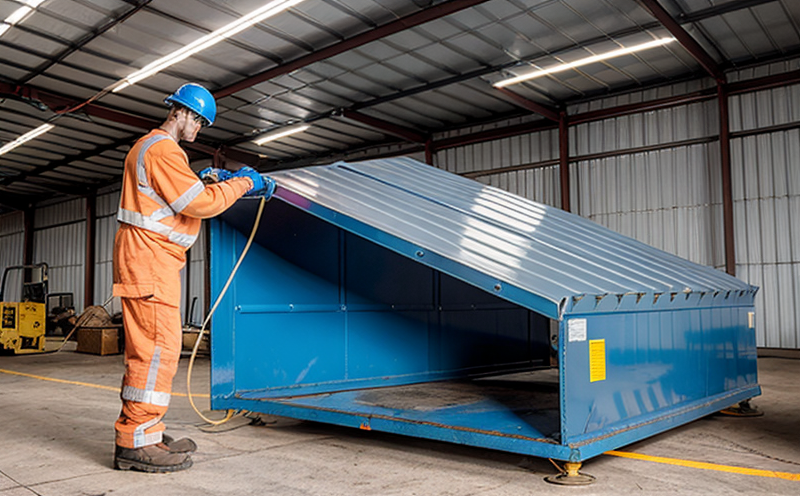Sheet metal lifter inspection
The sheet metal lifter is an essential piece of equipment used in manufacturing facilities and industrial settings. It plays a crucial role in lifting and positioning heavy sheets of metal for further processing, assembly, or transportation. The integrity and reliability of this equipment are vital to ensure safety and efficiency within the workplace. Regular inspection of these lifters helps identify potential issues before they escalate into larger problems that could lead to accidents or costly downtime.
Our sheet metal lifter inspection service provides a comprehensive evaluation of each component, ensuring it meets all necessary standards and specifications. This includes checking the integrity of welds, assessing wear patterns on critical parts, verifying alignment with lifting capacities, and confirming overall structural soundness. By employing advanced non-destructive testing (NDT) methods such as ultrasonic testing or magnetic particle inspection, we can detect hidden flaws that may not be visible through visual inspections alone.
When considering the lifecycle of a sheet metal lifter, it’s important to understand both its initial installation and subsequent maintenance. Proper setup ensures that all components are correctly aligned and functioning at optimal levels from day one. Regular follow-up inspections allow us to track any changes over time so corrective actions can be taken early on if needed.
For quality managers and compliance officers responsible for maintaining safe working environments, it is critical to stay informed about the latest regulatory requirements related to lifting equipment. Our team stays up-to-date with industry best practices as well as relevant international standards such as ISO 4302:2017 or ASME PTC-2M-1995 which guide proper inspection procedures.
By choosing our sheet metal lifter inspection service, you gain peace of mind knowing that your equipment is being thoroughly evaluated by experts who understand the nuances involved in this specialized field. With our detailed reports and recommendations for improvements or repairs where necessary, you can confidently continue operating with confidence while minimizing risks associated with faulty machinery.
Applied Standards
The inspection of sheet metal lifters adheres strictly to several internationally recognized standards designed specifically for this type of equipment. These include:
- American Society of Mechanical Engineers (ASME) PTC 1-2014: This standard provides guidelines on the design, fabrication, inspection, and use of lifting appliances.
- British Standard Institution (BS 6345: Part 1): Covers all aspects related to the design, construction, installation, operation, maintenance, and decommissioning of lifting machinery.
- International Organization for Standardization (ISO) 9001:2015: Ensures that quality management systems are effective in meeting customer requirements and enhancing customer satisfaction.
The application of these standards ensures consistency across different inspection processes, providing a benchmark against which performance can be measured. It also helps to ensure compliance with local regulations while maintaining high levels of safety and reliability.
Industry Applications
| Application Area | Description |
|---|---|
| Automotive Manufacturing | Lifting large panels or sheet metals for assembly purposes. |
| Aerospace Fabrication | Handling delicate components that require precise lifting without damage. |
| Petrochemical Plants | Raising heavy containers of hazardous materials safely and efficiently. |
| Construction Sites | Loading and unloading bulky items like steel beams or prefabricated walls. |
The use cases for sheet metal lifters extend beyond just one industry; they are applicable in various sectors where heavy lifting is required. In automotive manufacturing, for example, lifters assist in moving large panels into place during final assembly stages. Aerospace fabrication benefits from the precision offered by these machines when handling delicate components that could be easily damaged if mishandled.
In petrochemical plants, the ability to safely raise and lower heavy containers filled with hazardous materials is crucial for both operational efficiency and worker safety. On construction sites, sheet metal lifters help transport bulky items such as steel beams or prefabricated walls between different areas of a project site.
International Acceptance and Recognition
- Australia/New Zealand Standards (AS/NZS): The AS/NZS series covers all aspects concerning the design, construction, installation, operation, maintenance, and decommissioning of lifting machinery.
- European Union Directives: EU directives provide a framework for harmonizing technical requirements among member states regarding lifting equipment.
- United States Occupational Safety & Health Administration (OSHA): OSHA regulations outline safety practices concerning the use and maintenance of lifting devices in workplaces.
The recognition given to these standards by countries worldwide adds significant credibility to our inspection services. Adhering to these internationally accepted benchmarks ensures that your sheet metal lifter meets stringent quality controls, thereby reducing liability risks for both employers and employees alike.





